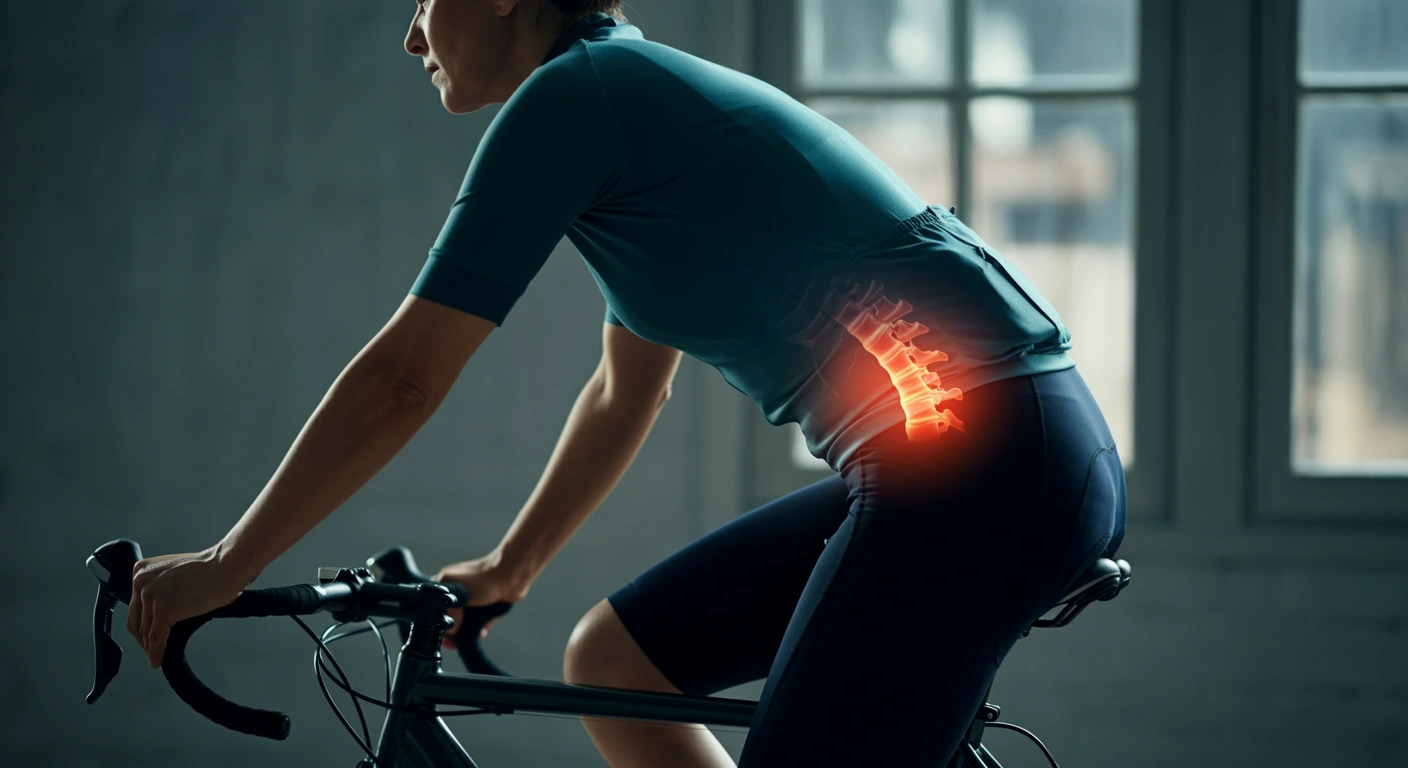Sciatica describes pain that follows the course of the sciatic nerve, extending from the buttocks down the leg. This condition commonly occurs due to pressure on the nerve roots in the lumbar spine, related to herniated disks or bone spurs.
Cycling can relieve people with sciatica, yet an uncomfortable seat or incorrect height may aggravate the condition by putting pressure on the sciatic nerve. If biking worsens your symptoms, consider switching temporarily to a more comfortable form of cardiovascular exercise.
This blog post will delve into four key considerations for cycling with sciatica. We will explore the advantages, possible risks, preventive steps, and alternative cycling exercises for sciatica.
Is Cycling Good For Sciatica: 4 Factors to Consider

Sciatica presents with pain, weakness, numbness, and tingling caused by nerve irritation or pressure. It is regarded as a symptom rather than a standalone medical condition, signaling an underlying health concern. Here, we delve into the factors linked to sciatica in cyclists.
Proper Bike Fit: Importance of Ergonomics
Having a bike that fits you well is very important. A good fit ensures you are comfortable and helps prevent further injury. Here’s what to keep in mind:
- Seat Height: Position the seat to ensure the leg is almost fully extended before the pedal reaches its lowest point.
- Handlebar Position: The handlebars should be high enough so you don’t have to hunch over.
✔ Top Pick: Home Bike Fit Tool
Many people use a home bike-fit tool to dial in seat height and handlebar reach so their lower back stays supported.
Choosing the Right Bike: Road Bike vs. Stationary Bike
Not all bikes are the same, and choosing the right one can make a big difference for someone with sciatica.
- Road Bike: Good for outdoor cycling, but make sure it has a comfortable seat.
- Stationary Bike: Easier to control the environment and intensity. Some have back supports that can reduce strain on your spine.
Optimal Cycling Posture: Avoiding Strain
How you sit on your bike matters. Posture plays an important role in reducing pain and preventing more injuries.
- Straight Back: Keep your back straight and avoid leaning too far forward.
- Relaxed Shoulders: Keep your shoulders relaxed to avoid tension.
- Natural Spine Position: Ensure your spine is neutral and not overly arched or rounded.
✔ Top Pick: Lower-Back Support Belt
Many people use a lower-back support belt to keep their spine stable during activity and reduce flare-ups.
Gradual Increase in Strenuous Activities: Preventing Flare-Ups
When starting out, it’s important not to push yourself too hard. Gradually increasing the intensity of your rides can help prevent flare-ups.
- Start Slow: Begin with short, easy rides.
- Increase Gradually: Slowly increase the distance and intensity of your rides.
Cycling For Sciatica: 4 Benefit
Cycling offers an effective solution for managing and easing sciatica symptoms. Below are the significant advantages of adding cycling to your routine if you experience sciatica:
Low-Impact Exercise: Gentle on Joints
Low-impact exercises like cycling are easy on your joints. Unlike running or jumping, cycling doesn’t put a lot of stress on your knees or hips. This makes it an excellent option for people with sciatica, as it reduces the risk of further injuring the lower back.
Improved Blood Circulation: Promotes Healing
When you cycle, your blood circulation improves. By increasing blood flow, nutrients, and oxygen are delivered to muscles, speeding up healing. For those with sciatica, this means reduced inflammation and faster recovery from flare-ups.
Strengthening Core Muscles: Supporting the Lower Back
Cycling helps strengthen your core muscles, including your abdomen and back. A strong core supports your lower back, which can help manage sciatica pain. When your core is strong, it takes pressure off your spine, reducing the likelihood of sciatica symptoms.
Releasing Endorphins: Natural Pain Relief
Physical activity like cycling releases endorphins, which are natural painkillers your body produces. These endorphins can help reduce the pain associated with sciatica, making it easier to manage daily activities. Regular cycling can lead to a consistent release of these helpful chemicals, providing ongoing relief.
Cycling with Sciatica: 3 Potential Risks

To safeguard your well-being and ensure a comfortable ride, it’s crucial to understand the associated risks of cycling with Sciatica. Here, we delve into the potential hazards of this condition.
Overexertion: Risk of Worsening Symptoms
Cycling can be great for your health, but it’s important not to overdo it. Overexertion can make your sciatica symptoms worse.
- Pushing Too Hard: High-intensity or long rides can strain your back.
- Ignoring Pain: Riding through pain can lead to more serious issues.
Poor Posture: Impact on Lower Back and Sciatic Nerve
Your posture while cycling can affect your lower back and sciatic nerve. A poor posture can increase pain and discomfort.
- Slouching: Bending too much at the waist can pressure your lower back.
- Tense Shoulders: Keeping your shoulders tight can cause strain in your upper back and neck.
- Incorrect Spine Alignment: Not keeping your spine neutral can worsen sciatica symptoms.
Inappropriate Bike Settings: Ensuring Comfort and Safety
Having your bike set up incorrectly can lead to discomfort and potential injury.
- Wrong Seat Height: A seat that is too high or too low can strain your legs and back.
- Improper Handlebar Position: Handlebars that are too low or too high can force you into an uncomfortable position.
- Uncomfortable Seat: A hard or poorly designed seat can pressure your sciatic nerve.
Cycling with Sciatica: 4 Prevention Tips

Cycling can worsen sciatica pain with poor bike setup or riding techniques. Selecting the right bike, keeping good form, and listening to your body are crucial. Engaging in proper cycling practices helps prevent sciatic pain from worsening on rides.
Warm-Up and Stretching: Preparing Your Body
Before you start cycling, it’s important to warm up and stretch. This will prepare your body and help prevent injuries.
- Warm-Up Exercises: Do gentle activities like walking or light pedaling for 5-10 minutes.
- Stretching: Focus on stretches that loosen your back, legs, and hips.
Using a Supportive Seat: Reducing Pressure on the Sciatic Nerve
A good seat can make a big difference when cycling with sciatica. It helps reduce pressure on your sciatic nerve.
- Padded Seat: Choose a seat with extra padding for more comfort.
- Proper Fit: Make sure the seat is the right size and shape.
- Cut-Out Design: Some seats have cut-outs to relieve pressure on sensitive areas.
✔ Top Pick: Pressure-Relief Saddle
Many people use a pressure-relief saddle to ease numbness and soreness caused by nerve compression.
Taking Breaks: Allowing Time for Rest and Recovery
It’s important to take breaks while cycling to give your body time to rest and recover.
- Frequent Stops: Plan to stop every 20-30 minutes, especially on longer rides.
- Stretch During Breaks: Use these breaks to stretch and relax your muscles.
- Shorter Rides: Start with shorter rides and gradually increase the duration as you get used to it.
Listening to Your Body: Recognizing When to Stop
Pay attention to how your body feels during and after your ride. Knowing when to stop can help prevent further injury.
- Watch for Pain: If you feel any sharp or increasing pain, take a break or stop riding.
- Fatigue Signs: It might be time to end your ride if you feel overly tired.
- Post-Ride Check: Check in with your body after your ride to ensure you haven’t overdone it.
Managing Sciatica While Cycling: 4 Alternative Exercises

A diverse array of exercises, stretches, and techniques to effectively manage the discomfort associated with sciatica pain while simultaneously enhancing your flexibility and overall well-being. Here, we explain some alternative exercises for cyclists to manage sciatica.
Swimming: Low-Impact and Full-Body Workout
Swimming is an excellent exercise for people with sciatica. It’s low-impact and provides a full-body workout without stressing your joints.
- Gentle on Joints: The water supports your body, reducing the impact on your back and legs.
- Full Range of Motion: Swimming helps you move all parts of your body, which can improve flexibility and strength.
- Cool and Relaxing: Being in the water can also help reduce inflammation and soothe pain.
Yoga and Stretching: Improving Flexibility and Reducing Pain
Exercising and practicing yoga are extremely beneficial for managing sciatica. They help improve flexibility and reduce pain.
- Stretching Muscles: Focus on gentle stretches for your hamstrings and hips.
- Yoga Poses: Poses like Child’s Pose and Downward Dog can help relieve pressure on the sciatic nerve.
- Breathing Techniques: Deep breathing during yoga can help relax your muscles and reduce tension.
Walking: Simple and Effective Exercise
Walking is one of the simplest and most effective exercises for sciatica. It’s easy to do and doesn’t require any special equipment.
- Low-Impact: Walking is gentle on your joints and can be done anywhere.
- Improves Circulation: Regular walking helps improve blood flow, aiding healing.
- Strengthens Muscles: Walking helps strengthen your legs and lower back muscles, providing better support for your spine.
Strength Training: Building Supportive Muscles
Strength training can help build muscles that support your spine and reduce sciatica pain.
- Focus on Core Muscles: Exercises like planks and bridges strengthen your abdomen and back muscles.
- Leg Strength: Lunges and squats can help build strong leg muscles that support your lower back.
- Proper Form: Always use proper form to avoid injury, and consider working with a trainer if you’re new to strength training.
Incorporating these alternative exercises into your routine allows you to manage your sciatica effectively while enjoying various activities.
Conclusion
What a journey it’s been, right? As we navigated the complex world of sciatica and the perks of cycling, it’s evident that cycling can truly revolutionize things. Yet, it’s crucial to understand it’s not a one-size-fits-all fix.
Listening to your body, taking breaks, and easing into it are key. Options like yoga, swimming, and walking can also complement this path. Each step matters in managing sciatica well.
Whether you’re gearing up for biking or exploring other avenues, remember – every choice leads to a healthier, happier you. Stay safe on your rides and prioritize your well-being.
FAQs
What Exercises Should Avoid Sciatica Sufferers?
To avoid exacerbating sciatica, individuals should skip exercises that involve forward bends, burpees, stiff-leg deadlifts, sit-ups, Russian twists, double-leg lifts, bent-over rows, and high-impact exercises.
What Is The Best Amount Of Walking For Sciatica?
Walking can help manage sciatica, but caution is advised to avoid exacerbating the pain. A doctor may suggest shorter walks with a gradual increase in duration. Taking breaks when needed is crucial for overall comfort and well-being.


